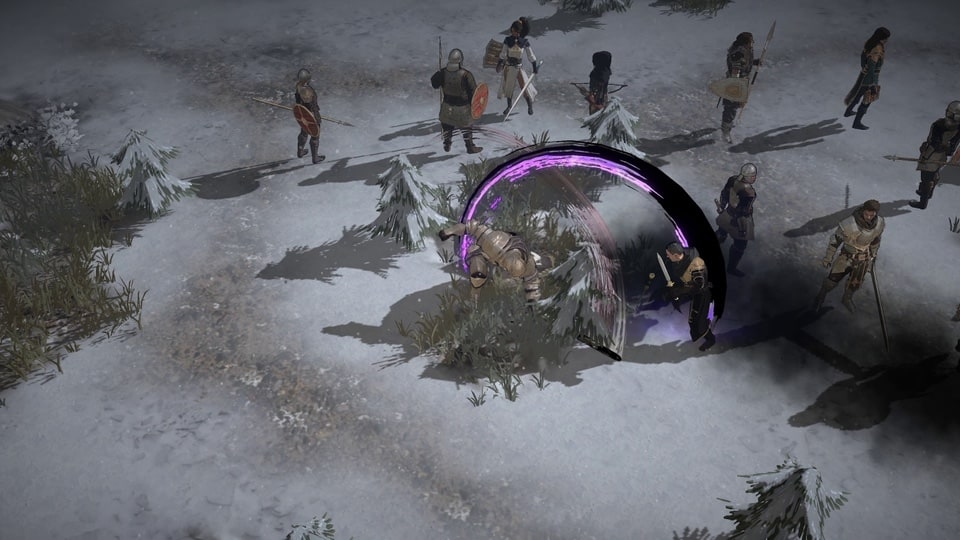There’s something about handheld gaming that just seems to fit with tactical games. Nintendo in particular, have regularly married the two, with series like Fire Emblem forming part of the bedrock of their handheld gaming lineup for many years. So, while Lost Eidolons: Veil of the Witch is out for all the major platforms, it’s a natural for the Nintendo Switch, fusing Fire Emblem-esque strategy and storytelling with Roguelike progression.
That said, Lost Eidolons: Veil of the Witch doesn’t make the best first impression on Nintendo Switch (by way of Switch 2’s compatibility layer), and a big part of that is in-game visuals. I initially started playing the game in handheld mode, and while the character artwork is detailed and characterful, the in-game visuals seemed very basic indeed. It looks better when you play docked, but it’s still pretty rough around the edges. It’s a testament to the quality of the gameplay that you’ll find yourself drawn into the tactical action, despite this, and the longer I spent with the game, the less I noticed.
There’s definitely a strong flavour of Fire Emblem in every gulp of Lost Eidolons: Veil of the Witch. You move your team of characters around a grid, facing off against a slew of different enemies, and if you want to be successful, you have to consider positioning, weaponry types, weaknesses and individual strengths.
While Fire Emblem has a straightforward weapon triangle of strengths and weaknesses to consider, Veil of the Witch takes this a step further with weapons and armour types with paired affinities. That means that heavy armour is weak to axes, leather armour is weak to swords, and cloth armour is weak to spears and bows. Besides that, some larger creatures will have different weaknesses depending on their positioning, and you’ll pour a lot of thought into where you’re going to send your team.
As you’d expect, there’s melee, ranged and magical attacks and support spells, as well as unique moves for each character. For all of these traditional trappings, the roguelike progression, and multiple runs into this fantasy world really do bring a newfound sense of freshness to the tactical action. Part of that comes down to decisions.
Every time your characters level up, you’re given two possible upgrades to equip them with, so you have to decide between better defence and improved attack, or enhanced movement and increased critical hit chance. Each run, there’s a chance to build them differently, and having that extra sword to spin makes Veil of the Witch consistently compelling.
Alongside levelling up, there’s further choices to be made following each battle. Here you can choose your route through the world, with an indication of the type of reward you’ll gain for heading in that direction,
Despite the repeated trips through the game world, there’s a story to be told, with Sable, the titular Eidolon, using your crew to further her own shadowy motives, bringing you back from the dead over and over again. While Veil of the Witch is often a little worthy, and there’s a lot of thou, thee and verily in the dialogue, you start to find the characters quietly endearing, learning more about them as you progress, often via one-to-one conversations back at your base.
Once again, that brings the Fire Emblem comparisons come even closer, but the feel and tone of Veil of the Witch is fundamentally very different from Intelligent Systems’ iconic franchise, and it absolutely stands as its own thing. It draws you in far more effectively than you might be expecting, and if you’re looking for a tactical RPG that is a little more respectful of your time, Veil of the Witch fits the bill perfectly.
Runs probably do run longer than you’d expect for the Roguelite genre. You’ll find battlefields that you thought you were finishing up suddenly beset by reinforcements, or small skirmishes where enemy fighters are repeatedly resurrected. These extend your time in certain battles, slowing your progress, especially when you’re facing an almost inevitable death. Equally, there’s as much challenge and depth to each encounter as you’ll find in the best of the genre, and there’s plenty of variation to the way that battles play out, with different conditions changing things up. Overall, I’d rather have the thoughtful, engaging strategy, rather than it becoming a frantic jog through multiple encounters.







Great review! It’s interesting to see how handheld gaming enhances the tactical experience in Lost Eidolons: Veil of the Witch. The combination of strategy and portability really appeals to many gamers. Looking forward to more insights!